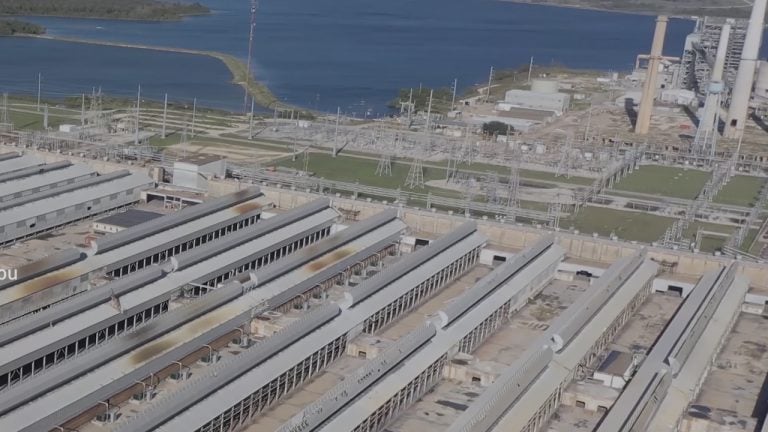 The Amesbury, Massachusetts-based Bankprov, a subsidiary of Provident Bancorp, has announced that it will no longer provide loans secured by cryptocurrency mining rigs. In a filing with the U.S. Securities and Exchange Commission (EX-99.1), Bankprov stated that revenue from its digital asset loan portfolio will continue to decrease as the company has discontinued new loan […]
The Amesbury, Massachusetts-based Bankprov, a subsidiary of Provident Bancorp, has announced that it will no longer provide loans secured by cryptocurrency mining rigs. In a filing with the U.S. Securities and Exchange Commission (EX-99.1), Bankprov stated that revenue from its digital asset loan portfolio will continue to decrease as the company has discontinued new loan […]
The Bitcoin network hashrate has returned to 241.29 EH/s after a temporary 38% fall to 170.60 EH/s from a weekly peak of 276.40 EH/s.
Bitcoin’s network hashrate has returned to regular levels again, days after freezing temperatures across the United States put a strain on the nation's electricity grid — leading to a temporary drop in hashrate.
In the days leading up to Christmas, bone-chilling temperatures swept across the United States, leading to millions without power and claiming at least 28 lives.
According to reports, Bitcoin miners in Texas, which accounts for a significant portion of the country's hashrate, voluntarily curtailed operations to give power back to the grid — so that residents can keep their homes heated.
The disruptions appear to have put a dent in Bitcoin’s hashrate, which typically hovers around 225-300 Exahashes per second (EH/s). This fell to 170.60 EH/s on Dec. 25.
As of Dec. 26 however, the hashrate has returned to 241.29 EH/s, according to data from hashrate mining calculator CoinWarz.
Bitcoin’s hashrate is calculated by measuring the number of hashes produced by Bitcoin miners trying to solve the next block. It is regarded as a key metric in assessing how secure the Bitcoin network is.
The recent events prompted a controversial statement from FutureBit founder John Stefanop, who suggested the fall in hashrate was due to a number of “highly centralized mines” in Texas turning off at the same time.
“I know, does not change the fact that a few large mines in Texas affect the entire network to the tune of 33%...everyones transactions are now being confirmed 30% slower because the hashrate is not decentralized enough,” he said.
“If hashrate was distributed evenly around the world by 10’s of millions of small miners instead of a few dozen massive mines, this event would not have even registered on the network,” Stefanop added.
Bitcoin bull Dan Held however refuted Stefanop’s take on the events, arguing that weather patterns do not mean centralized ownership or control.
According to the Cambridge Bitcoin Electricity Consumption Index, the United States accounts for 37.84% of the average monthly hashrate share. The top four states in the country for Bitcoin mining include New York, Kentucky, Georgia and Texas — all of which had experienced power outages due to the winter storm.
However, Dennis Porter, the CEO of Bitcoin mining advocacy group Satoshi Action Fund noted to his 127,400 Twitter followers on Dec. 25 that while the inclement weather, particularly in Texas, caused 30% of Bitcoin’s hashrate in the United States to go offline, the network “continues to work perfectly.”
Over 30% of the #Bitcoin hashrate has gone offline due to extreme weather in Texas and yet the global #Bitcoin network continues to work perfectly.
— Dennis Porter (@Dennis_Porter_) December 25, 2022
Now imagine if Amazon or Google tried turning off 1/3rd of their data centers. pic.twitter.com/G49iqBZXDL
Cheap power and favorable mining regulation in Texas has led to a Bitcoin mining boom in Texas in recent months, which is now host to some of the largest mining companies in the world.
Among those Riot Blockchain, Argo, Bitdeer, Argo, Compute North, Genesis Digital Assets and Core Scientific — who’ve recently received a $37.4 million bankruptcy loan to stay afloat.
Related: 'There's a lot less land to go around' — Why White Rock established off-the-grid mining in Texas
However recent weather events have only added to Bitcoin mining companies’ list of headaches.
The bear market has plagued Bitcoin mining companies to the tune of $4 billion in debt, according to recent data.
Many notable U.S. based mining companies have filed for bankruptcy in recent months too, while many other companies are approaching near-insurmountable debt-to-equity ratios that require immediate restructuring.
The tragic weather events haven’t impacted the price of Bitcoin (BTC) thus far, which is currently priced at $16,826 — only down 0.27 over the last 24 hours.
 On Nov. 28, 2022, the crypto lender Blockfi informed the public via a press release that the company has voluntarily petitioned for Chapter 11 bankruptcy protection. Blockfi is now one of many digital currency businesses dealing with significant financial hardships and bankruptcy proceedings in 2022. Blockfi Voluntarily Petitions for Chapter 11 Bankruptcy Protection Blockfi has […]
On Nov. 28, 2022, the crypto lender Blockfi informed the public via a press release that the company has voluntarily petitioned for Chapter 11 bankruptcy protection. Blockfi is now one of many digital currency businesses dealing with significant financial hardships and bankruptcy proceedings in 2022. Blockfi Voluntarily Petitions for Chapter 11 Bankruptcy Protection Blockfi has […] Digital asset mining and staking firm Foundry has agreed to purchase two “turnkey” bitcoin mining facilities from Compute North, a bitcoin miner that filed for Chapter 11 bankruptcy protection on Sept. 22, 2022. Foundry says the two data centers have a total power capacity of around 17 megawatts (MW), and the company also has the […]
Digital asset mining and staking firm Foundry has agreed to purchase two “turnkey” bitcoin mining facilities from Compute North, a bitcoin miner that filed for Chapter 11 bankruptcy protection on Sept. 22, 2022. Foundry says the two data centers have a total power capacity of around 17 megawatts (MW), and the company also has the […] Another bitcoin mining company is dealing with financial issues as Iris Energy’s Form 6-K filing with the U.S. Securities and Exchange Commission (SEC) shows the company could face default on two loans. Iris Energy’s Form 6-K filing explains to the SEC that the firm “received a notice from its lender alleging the occurrence of an […]
Another bitcoin mining company is dealing with financial issues as Iris Energy’s Form 6-K filing with the U.S. Securities and Exchange Commission (SEC) shows the company could face default on two loans. Iris Energy’s Form 6-K filing explains to the SEC that the firm “received a notice from its lender alleging the occurrence of an […] On Oct. 31, 2022, the publicly-listed bitcoin miner Argo Blockchain revealed the firm’s attempt to obtain $27 million in a scheduled financing deal fell through. According to the company’s October update, Argo said it did not believe the deal “will be consummated” and now two market analysts have downgraded the company’s shares. Argo Blockchain’s $27 […]
On Oct. 31, 2022, the publicly-listed bitcoin miner Argo Blockchain revealed the firm’s attempt to obtain $27 million in a scheduled financing deal fell through. According to the company’s October update, Argo said it did not believe the deal “will be consummated” and now two market analysts have downgraded the company’s shares. Argo Blockchain’s $27 […]
Marathon has outlined that at this stage its operations hosted by Compute North will continue to operate as usual, and highlighted an improved BTC mining production in Q3.
Bitcoin (BTC) miner Marathon Digital Holdings has revealed $81.3 million worth of exposure to recently bankrupted mining hosting provider Compute North.
Marathon provided a breakdown of its exposure on Oct. 6 explaining the majority was in operating deposits worth $50 million, noting these deposits “were primarily related to King Mountain and Wolf Hollow security deposits and prepayments associated with the ongoing operation of those sites.”
The remainder is split between $21.3 million allocated to “an unsecured senior promissory note” and $10 million in convertible preferred Compute North stock.
It comes weeks after Compute North submitted a Chapter 11 bankruptcy filing in the United States Bankruptcy Court for the Southern District of Texas on Sept. 23.
Under a Chapter 11 filing, the firm is able to keep its operations going as it works out plans to restructure and repay creditors.
Marathon Digital said portions of its BTC mining operations are hosted by Compute North in locations such as Texas, Nebraska and South Dakota. The firm has outlined that at this stage, its operations hosted by Compute North will continue to operate as usual.
“Based on the information available today, we do not anticipate these proceedings impacting our current operations or our ability to achieve our primary target of 23 exahashes per second in 2023.”
— Marathon Digital Holdings (NASDAQ: MARA) (@MarathonDH) October 6, 2022
“Marathon has not experienced any significant negative impacts on its operations at King Mountain, where miners continue to be energized according to schedule,” the firm stated, but noted it had “experienced some delays at Wolf Hollow [Texas], which Compute North has attributed to a regulatory matter.”
While miner profit margins are bound to have been tighter given the bearish nature of BTC this year, Marathon emphasized that its operational performance is improving.
During the third quarter of 2022 Marathon mined 616 BTC — worth $12.3 million at current prices — with the firm highlighting that production significantly ramped up month-over-month, going from 72 BTC and 184 BTC in July and August respectively, to 360 BTC in September.
Related: Grayscale announces new arm to invest in Bitcoin mining hardware
By the end of September, Marathon stated it had an operating mining fleet consisting “of approximately 37,000 active miners” producing around 3.8 Exahases per second (EH/s). However, the total has increased significantly since then, with 57,000 active miners producing 5.7 EH/s as of Oct. 5.
Marathon also outlined that its total BTC holdings reached 10,670 BTC, with a fair market value of around $207.3 million as of Sept. 30, while unrestricted cash on hand hit $55.3 million.
 According to a representative from the bitcoin mining company backed by the Chinese crypto billionaire Jihan Wu, Bitdeer is crafting a $250 million fund to buy distressed assets from embattled bitcoin miners. Bitdeer’s chief executive officer Matt Kong details that “opportunities” arise in “every cycle.” Bitdeer Wants to Acquire Cheap Machines From Distressed Bitcoin Miners […]
According to a representative from the bitcoin mining company backed by the Chinese crypto billionaire Jihan Wu, Bitdeer is crafting a $250 million fund to buy distressed assets from embattled bitcoin miners. Bitdeer’s chief executive officer Matt Kong details that “opportunities” arise in “every cycle.” Bitdeer Wants to Acquire Cheap Machines From Distressed Bitcoin Miners […] Bitcoin mining firm Compute North filed for Chapter 11 bankruptcy protection in Texas on Thursday as the crypto winter continues to put pressure on crypto mining operations. The bankruptcy petition filed on September 22, indicates the company looks to stabilize operations in order to repay creditors. Compute North Files for Chapter 11 Bankruptcy Protection Five […]
Bitcoin mining firm Compute North filed for Chapter 11 bankruptcy protection in Texas on Thursday as the crypto winter continues to put pressure on crypto mining operations. The bankruptcy petition filed on September 22, indicates the company looks to stabilize operations in order to repay creditors. Compute North Files for Chapter 11 Bankruptcy Protection Five […]
Compute North’s hosting partners Compass Mining have stated that the firm will continue to operate business as usual at this stage.
Bitcoin (BTC) mining hosting firm Compute North has filed for chapter 11 bankruptcy, amid growing pressure on the firm due to the effects of crypto winter and rising energy costs. The firm’s CEO Dave Perrill has also stepped down but will remain on the board.
The company submitted a Chapter 11 bankruptcy filing in the U.S. Bankruptcy Court for the Southern District of Texas on Sept. 22, which is now pending before Judge David Jones.
Under a Chapter 11 filing, the firm is still able to keep its operations going as it works out a plan to repay creditors. The filing reportedly outlines that Compute North owes around $500 million to 200 creditors, while its assets are said to be worth between $100 million and $500 million.
Compute North offers large scale crypto mining hosting services and facilities, hardware and a BTC mining pool. It is one of the largest data center providers in the U.S. has big name partners in the BTC mining sector such as Compass Mining and Marathon Digital.
Both companies have come out with statements via Twitter, noting that with the information they have at this stage, their business operations will continue as normal.
“Compute North’s staff informed us today that the bankruptcy filing should not disrupt business operations. We are continuing to monitor the situation and will provide further updates as they become available,” noted Compass Mining.
Today, a filing related to one of our hosting providers was published. Based on the information available at this time, it is our understanding that this filing will not impact our current mining operations.
— Marathon Digital Holdings (NASDAQ: MARA) (@MarathonDH) September 22, 2022
The bearish performance of BTC in 2022 has had a significant impact on the mining sector this year, and in the context of Texas, rising energy costs and multiple power outages during intense heat waves haven’t helped either.
Related: Maple Finance launches $300M lending pool for Bitcoin mining firms
Bloomberg Business reporter David Pan highlighted on Twitter that Compute North may have been impacted by a costly delay to a large mining facility in Texas that it wasn’t able to monetize for months.
“Compute North’s massive 280MW mining facility in TX was supposed to run rigs in April but it couldn’t due to pending approvals. From then to later this year when it finally was able to energize the machines, Bitcoin prices had gone through multiple downward cycles, fundraising opportunities dried up and major lenders scaled back,” he wrote.
Compute North adds to a long list of crypto firms that have either fallen victim to crypto winter — or in some cases helped create it — including Voyager Digital, Three Arrows Capital, Celsius Network and BlockFi to name a few.